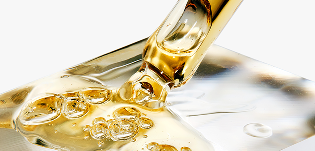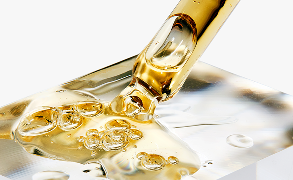Hyaluronic acid is a powerful skincare ingredient with a remarkably simple primary function: to hydrate the skin by binding and retaining water. It plays a key role in The Ordinary’s formulations and is one of the focal points of any skincare regimen.
In this ingredient deep dive, we break down the basics of hyaluronic acid and its long-lasting benefits for your skin.
What is Hyaluronic Acid?
Hyaluronic acid is a naturally occurring substance throughout the body, found in the skin, eyes, joints, and muscles. It’s considered one of the most well-known ingredients for hydration and healthy-looking skin.
But there’s a catch: hyaluronic acid levels naturally decline as we get older. The decrease in natural hyaluronic acid levels makes it a potential contributing factor to some ageing concerns associated with water loss, such as fine lines and poor skin elasticity.
Our bestselling Hyaluronic Acid 2% + B5 (Original Formulation) targets issues like these, improving skin elasticity and working to hydrate and plump the appearance of fine, dry lines immediately.
Despite its name, hyaluronic acid isn’t acidic. It gets the “acid” part of its name from uronic acid (one of the molecules in its molecular structure), but it doesn’t act like an exfoliator.
Instead, its name refers to different sizes of sugar-based molecules often found in its sodium salt form, also known as sodium hyaluronate. We call this a polysaccharide compound.
These compounds can organise themselves into different-sized mesh-like structures, ranging from super-small, hydrolyzed hyaluronic acid to a large hyaluronic acid crosspolymer of varying weights.
Picture them like building blocks, attaching and growing in different ways and sizes. It’s this adaptable nature that allows hyaluronic acid to play multiple roles in the body. We find it in many skeletal tissues and organs but most abundantly in the skin, accounting for around 50% of the body’s hyaluronic acid.

What Does Hyaluronic Acid Do For the Skin?
The molecular structure of hyaluronic acid has multiple points that can hold onto water molecules. These are called hydroxyl groups and are represented as either -OH or -HO. When applied to the skin, hyaluronic acid will do just that: hold onto water to keep the skin hydrated.
(Chemist’s tip: the more -OH groups you see in the molecular structure of a compound, the more water it will be able to hold).
For this reason, hyaluronic acid is frequently referred to as a water magnet. Its bonds with water molecules are effective at supporting hydration, and are strong enough to hold onto water but not so much that it could attract or pull in water from elsewhere. This is a misconception that leads some to believe hyaluronic acid causes dehydration by drawing water from deeper layers of the skin, especially in dry environments.
Benefits of Using Hyaluronic Acid for Skin
Dehydration is associated with multiple skin concerns, which is why so many of the benefits of hyaluronic acid lie in its ability to retain water.
The consistent use of a hyaluronic acid serum in your skincare routine can lead to:
- Immediate hydration and plumping: Hyaluronic acid draws moisture to the skin’s surface, providing an instant boost in hydration that visibly plumps and refreshes the skin.
- Reduction in the appearance of fine, dry lines: By keeping skin hydrated, hyaluronic acid helps to reduce the look of fine lines that are often more noticeable when the skin is dry or dehydrated.
- Enhanced skin smoothness and softness: The added hydration from hyaluronic acid helps create a smoother skin surface, enhancing softness and improving overall skin feel.
- Improved skin texture: Proper hydration supports the natural shedding of dead skin, a process that relies on water to keep skin texture smooth. Excessive water loss disrupts this process, leading to irregular shedding and uneven texture.
Hyaluronic Acid Molecular Weights + Penetration

Due to its structure, hyaluronic acid can create a large spectrum of molecule sizes. Formulations that include many different sizes of hyaluronic acid can help hydrate multiple layers of the skin’s surface.
This is why our latest formulation of Hyaluronic Acid 2% + B5 (with Ceramides) contains five forms of hyaluronic acid:
- Low, medium, and high molecular weights: A combination of molecular weights of sodium hyaluronate that provide hydration across multiple levels of the skin’s surface
- Sodium hyaluronate crosspolymer: A type of hyaluronic acid that forms a protective mesh on the skin's surface
- Hydrolyzed hyaluronic acid: A very low-molecular weight of hyaluronic acid added to our Hyaluronic Acid 2% + B5 (with Ceramides) formulation
How to Use Hyaluronic Acid in Your Skincare Routine

Incorporating a hyaluronic acid serum into your skincare regimen is easy. This versatile ingredient can be used morning and night and works well with other formulations.
As always, we recommend following the 3 core stages of a skincare regimen to layer your formulations.
Step 1: Prep
This involves cleansing the skin and preparing it for treatment.
Apply a hyaluronic serum like our Hyaluronic Acid 2% + B5 (with Ceramides) after washing your face with a cleanser and toner.
Step 2: Treat
This stage addresses specific skin concerns with targeted formulations.
We recommend using a hyaluronic acid serum before water-free serums, oils or suspensions/creams.
Step 3: Seal
This step locks in formulations and supports the skin barrier to protect against external stressors.
Apply hyaluronic acid before anhydrous oils and creams like Natural Moisturizing Factors + HA.
It helps to remember 4 key factors when using our hyaluronic acid serums in your daily skincare routine.
1. When Unsure, Patch Test
Before use, apply a small amount to the upper forearm, keep the area dry, and observe for 24 hours. If irritation occurs, rinse immediately and avoid use on the face.
2. Less is More
Apply a few drops—too much may leave a residue—to clean, dry skin in the morning and evening. Damp skin doesn’t necessarily improve hydration.
3. Pat In and Let Dry
After applying, lightly pat the product in and allow it to dry naturally. Avoid excessive rubbing, as it may cause stickiness.
4. Use as Directed on Unbroken Skin:
Apply only to unbroken skin and follow instructions. If irritation occurs during use, rinse thoroughly, stop use, and consult a physician.
How Often Should You Use Hyaluronic Acid?
Hyaluronic acid is a gentle, versatile ingredient that fits easily into your daily skincare routine. With continued use, you may experience smoother, firmer, and more hydrated skin.
Hyaluronic acid’s hydrating properties make it:
- Perfect for daily skin hydration maintenance: Using hyaluronic acid daily helps moisturise your skin, softening fine, dry lines and supporting your skin barrier.
- Great for year-round use: Whether it’s winter dryness or summer heat, hyaluronic acid is ideal when you’re looking for consistent hydration.
- Compatible with other skincare ingredients: Thanks to its gentle nature, hyaluronic acid pairs well with other ingredients, making it easy to fit into any skincare routine.
- Suitable for all skin types: Both our Hyaluronic Acid 2% + B5 (Original Formulation) and Hyaluronic Acid 2% + B5 (with Ceramides) serums offer lightweight hydration for all skin types, without clogging pores.


 Claim Your 10% Off
Claim Your 10% Off


